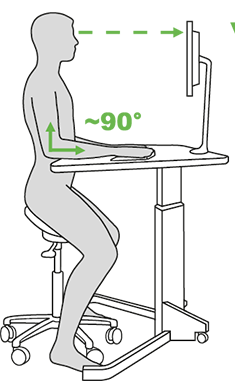When using a saddle seat, you must sit much higher than usual in order to experience the health benefits associated with saddle sitting. Your body should be positioned mid-way between sitting and standing. Some folks call this a “high-straddle,” “perch,” or “sit-stand” posture.

Sitting down and getting up
Stand beside the chair, lift one leg over the chair, from the back, to the other side of the chair and sit down. To get up, move your feet slightly forward and stand up. This chair remains behind you when you stand up.
Why? If you stand in front the stool and sit down as you would on a conventional chair, the stool may roll away from you.

Raise the seat
Start by raising the seat up too high, so that your feet do not reach the floor. Then lower the chair slowly until your feet are firmly on the floor. There should now about a 135° angle in the knees and at the hip (between the thighs and the upper body).
Why? The wide hip angle allows the pelvis to tilt forward and maintain the natural curve in the lower back. If you sit too low, your feet will drift to the front of your body rather than to the side of your body, which often results in a slouched posture and rounding of the back.

Sit toward the back of the saddle
When sitting your buttocks should be at the back edge of the chair.
Why? If you sit too far in the front, the pommel (rise) at the front of the seat, or the edges of the middle gap if you have a split seat, may press your inner thighs and genital area. In the correct position your sitting bones (ischial tuberosities) will be positioned in the softest and most contours place on the seat.

Keep your feet to the sides
The goal of riding-style sitting is achieve the same upright spinal posture as we you are standing. When viewed from the side, the shoulder, pelvis and heel are in line.
Why? If the feet drift forward toward the front of your body, your will rounded into an unhealthy slump. Moving the feet to the sides helps the pelvis tilt forward, enabling the natural curve in the lower back and straightening the spine.

Adjust seat width
If your saddle seat has width adjustment, simply adjust the width for comfort. This feature is available with the Salli SwingFit, Salli MultiAdjuster, and Kanewell 901S models. Men especially should make sure that the seat parts do not narrow during the day.

Move!
Saddle Stools make it easy to keep moving. You can easily scoot around your work area by pushing sideways with the one foot and pulling with the other. When you perch up high in a saddle, it’s easy to use your feet to roll around while in the chair (“saddle-walk”) to fetch things.

Move!
Always adjust your chair first, before you adjust your desk. In office and lab settings, work surfaces must be several inches higher than conventional a sitting-height desk.
Why? IIf you lower your saddle seat to accommodate a standard sitting-height desk, the saddle will be too low and you will slump.

